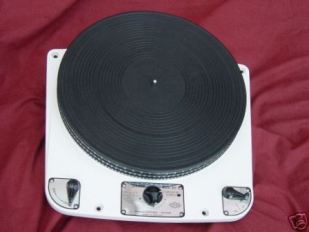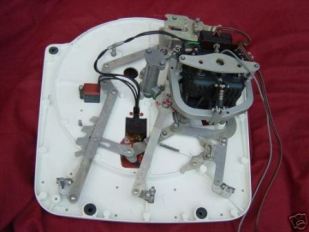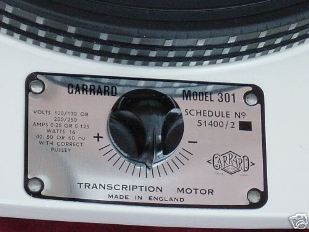-edible zone-
The System
The focus for building my system originally
was the source. I had already built up a modest system for family
enjoyment but it was digitally based; however my old turntable and
speakers happily co-existed with it. I thought about making step changes
in the system which would allow me to take my time and continue
listening to music with some elements of familiarity retained. This
approach soon lost its way to an insatiable desire to go completely
analogue for the sake of being more faithful from the ground up. In the
mythology the analogue sound is described as ‘natural’, ‘warm’,
‘organic’ and ‘pure’, yet these are no less attempts to capture the
modus operandi with the science of language as if it were the very magic
itself which could be bottled up by the alchemist and peddled by the
apothecary. I do enjoy these notions of personality or the
characteristics associated with analogue sound; they are helpful
descriptions. But using a magic potion as a way of experiencing sound is
not the same as accepting that the mode itself needn’t have a prescribed
sound at all, it is merely another belief in a means of getting closer
to the real magic.
The magic potion is a short cut to the dream
and euphonic in nature but to have accuracy is to see beyond these
preconceived notions and devices of language or else the approach would
be less faithful a reproduction. After all I should not allow the
language, however appealing to get confused with neutrality and accuracy
or the faithfulness I want for music recorded on vinyl. The more I
thought about my system the more I came to feel it was an all or nothing
situation or else I would not be satisfying my aims. This of course may
be an admirable ambition but whether right or wrong I later discovered
that it was simply impractical to build an entire audio system from the
ground up without some deviation from these principles. Choice, not
withstanding ones own infallible capability to make mistakes meant that
it would be a long though enjoyable road ahead and one which I still
travel.
The Turntable
I had been using a NAD 533
with Rega RB250 tone arm (which is based on the Rega Planar footprint).
I knew I wanted something more ‘robust’ and with ‘more control’; despite
knowing little about the science of sound reproduction I was able to
distinguish characteristics in this system which I felt could only be
described as ‘under performing’. The sound stage was not well defined;
placement of instruments was not always clear, the top end would ‘roll
off’, all leaving me frustrated; in short, an anti-climax. However
subjective my explanation, I knew instinctively it was not faithfully
reproducing what had been recorded. I have of course no master tapes
from which to disprove this assumption, but I knew also that the
limitations which gave rise to the same characteristics being
experienced across a host of different records made it a reasonably good
assumption to make.
Musicality is very subjective of course so I
wasn't too sure what specifically I should look for in a new turntable
and how that might reproduce the sound I thought I wanted. I researched
lot’s of turntables and narrowed my searches down to a few basic
criteria; it had to be vintage, I like period styling so knew what I
liked and didn't, I wanted British because I was interested in British
audio heritage and because I knew there was a confidence in British
audio engineering products of the past which would place me on a sound
footing. I wanted a system with a challenge but which I didn't need to
be an expert to tackle. I of course read reviews and got a sense for the
common characteristics associated with certain turntable models and how
they might fit with what I was looking for.
When I had finally
drawn up a small list of popular and well respected turntables; a
combination of looking at the projects undertaken by members of The
Analog Dept, the wonderfully informative labour of love at No 6435 and a
rather excellent article on a Garrard restoration project written by
Jeff Day in the Sept 2004 edition of 6moons all eventually persuaded me
to try a Garrard 301.
Without the rich wealth of information now
made available on Garrard transcription motor units, all thanks to those
early pioneers and revolutionaries, I could never have conceived of
choosing a Garrard and breathing new life back into it. Before I found
these labours of love twinkling in the depths of the audio underworld I
had of course been spellbound by the beautiful design of these decks,
they seemed to have an affinity with my hankering for the nostalgic. I
of course had heard the rumours of their class and what they could do;
their heritage was indeed of pedigree.
The birth of the 301 in
Swindon, England was of course a classically British affair and the
301's use for broadcasting purposes by the most enviable broadcasting
corporation in the world only fuelled my desire to own one; it all
played directly to my heart over my head. I cannot give a romanticised
story of discovering a vintage Garrard in an old studio looking
forgotten and shouting out for salvation or of growing up close to this
period of audio heritage. Like many before me I found myself searching
hard for a good example of this enviable motor unit and start the task
of learning what to do with it. Before those early pioneers offered a
way, these motor decks were almost forgotten despite their eminent
history and pedigree. Of course many units were produced by the Swindon
factory in its period since the 301 was launched in 1954 to the
production of the 401 in 1965 and since in their restoration by
dedicated enthusiasts.
The Garrard 301 remains a respected and
revered motor unit which requires passion to breathe new life into it. I
felt confident that if I could pull this off I would be rewarded like
the pioneers before me had been. I was fortunate to find a Garrard which
unlike many was in a reasonably good operable state. It looked clean,
had all components present and short of learning how to use it and
integrate it I needed very little technical knowledge to get it off the
ground. The unit needed a power cord, a replacement spark suppressor as
the motor pulley and eddy current disc ran when the unit was plugged in
at the mains but whilst in the 'off' position. The unit also ran fast,
too fast and no adjusting of the eddy current brake was going to
compensate for the speed at which it ran. A check of the linkage system
soon resolved this problem. Besides these minor problems, the motor deck
retained its 1950’s elegance and robustness in a gloriously clean cream
enameled finish, charming me with its period styling, the levers, the
embossed control labels in silver and black and a heavy steel platter
bejeweled with strobe markings. All cadmium plated linkages were
present, the motor suspension unit was in place, as well as a perfectly
operating motor, pulley, idler, and brake disk, spindle bearing, thrust
plate and electronics were also intact... I knew my vinyl was in for a
treat.
Pictured below is the Garrard 301 I tracked down. It is an oil bearing version, (Schedule 51400/2: Serial 5902) with a 50htz pulley.




It then followed quickly (almost naturally) that I should want to match this deck with a period tone arm, which was again sympathetic to my yearning for nostalgia, our British audio heritage and of a mechanical nature fitting with the deck. I had looked at Thomas Shick (a wonderfully elegant and highly respected tonearm), Shindo (truly a magician in the mountain.. beautiful audio) and Ortofon arms (another classic) but eventually and not unlike many before me I decided I would be served well with an SME tone arm, another classic piece of British audio heritage with pedigree